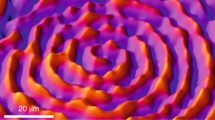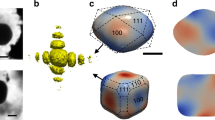Abstract
Chemical transformations at the interface between solid/liquid or solid/gaseous phases of matter lie at the heart of key industrial-scale manufacturing processes. A comprehensive study of the molecular energetics and conformational dynamics that underlie these transformations is often limited to ensemble-averaging analytical techniques. Here we report the detailed investigation of a surface-catalysed cross-coupling and sequential cyclization cascade of 1,2-bis(2-ethynyl phenyl)ethyne on Ag(100). Using non-contact atomic force microscopy, we imaged the single-bond-resolved chemical structure of transient metastable intermediates. Theoretical simulations indicate that the kinetic stabilization of experimentally observable intermediates is determined not only by the potential-energy landscape, but also by selective energy dissipation to the substrate and entropic changes associated with key transformations along the reaction pathway. The microscopic insights gained here pave the way for the rational design and control of complex organic reactions at the surface of heterogeneous catalysts.
This is a preview of subscription content, access via your institution
Access options
Subscribe to this journal
Receive 12 print issues and online access
$259.00 per year
only $21.58 per issue
Buy this article
- Purchase on Springer Link
- Instant access to full article PDF
Prices may be subject to local taxes which are calculated during checkout




Similar content being viewed by others
References
De Oteyza, D. G. et al. Direct imaging of covalent bond structure in single-molecule chemical reactions. Science 340, 1434–1437 (2013).
Björk, J., Zhang, Y., Klappenberger, F., Barth, J. V. & Stafström, S. Unraveling the mechanism of the covalent coupling between terminal alkynes on a noble metal. J. Phys. Chem. C 118, 3181–3187 (2014).
Di Giovannantonio, M. et al. Insight into organometallic intermediate and its evolution to covalent bonding in surface-confined Ullmann polymerization. ACS Nano 7, 8190–8198 (2013).
Hla, S.-W., Bartels, L., Meyer, G. & Rieder, K.-H. Inducing all steps of a chemical reaction with the scanning tunneling microscope tip: towards single molecule engineering. Phys. Rev. Lett. 85, 2777–2780 (2000).
Hulsken, B. et al. Real-time single-molecule imaging of oxidation catalysis at a liquid–solid interface. Nature Nanotech. 2, 285–289 (2007).
Riss, A. et al. Local electronic and chemical structure of oligo-acetylene derivatives formed through radical cyclizations at a surface. Nano Lett. 14, 2251–2255 (2014).
Zhou, H. et al. Direct visualization of surface-assisted two-dimensional diyne polycyclotrimerization. J. Am. Chem. Soc. 136, 5567–5570 (2014).
Sun, Q. et al. On-surface formation of one-dimensional polyphenylene through Bergman cyclization. J. Am. Chem. Soc. 135, 8448–8451 (2013).
Treier, M. et al. Surface-assisted cyclodehydrogenation provides a synthetic route towards easily processable and chemically tailored nanographenes. Nature Chem. 3, 61–67 (2011).
Heinrich, B. W. et al. Change of the magnetic coupling of a metal–organic complex with the substrate by a stepwise ligand reaction. Nano Lett. 13, 4840–4843 (2013).
Dienel, T. et al. Dehalogenation and coupling of a polycyclic hydrocarbon on an atomically thin insulator. ACS Nano 8, 6571–6579 (2014).
Bartels, L., Meyer, G. & Rieder, K.-H. Controlled vertical manipulation of single CO molecules with the scanning tunneling microscope: a route to chemical contrast. Appl. Phys. Lett. 71, 213–215 (1997).
Mohn, F., Schuler, B., Gross, L. & Meyer, G. Different tips for high-resolution atomic force microscopy and scanning tunneling microscopy of single molecules. Appl. Phys. Lett. 102, 073109 (2013).
Gross, L., Mohn, F., Moll, N., Liljeroth, P. & Meyer, G. The chemical structure of a molecule resolved by atomic force microscopy. Science 325, 1110–1114 (2009).
Gross, L. et al. Bond-order discrimination by atomic force microscopy. Science 337, 1326–1329 (2012).
Gross, L. et al. Organic structure determination using atomic-resolution scanning probe microscopy. Nature Chem. 2, 821–825 (2010).
Zhang, J. et al. Real-space identification of intermolecular bonding with atomic force microscopy. Science 342, 611–614 (2013).
Sweetman, A. M. et al.. Mapping the force field of a hydrogen-bonded assembly. Nature Commun. 5, 3931 (2014).
Hämäläinen, S. K. et al.. Intermolecular contrast in atomic force microscopy images without intermolecular bonds. Phys. Rev. Lett. 113, 186102 (2014).
Hapala, P. et al.. Mechanism of high-resolution STM/AFM imaging with functionalized tips. Phys. Rev. B 90, 085421 (2014).
Kawai, S. et al. Extended halogen bonding between fully fluorinated aromatic molecules. ACS Nano 9, 2574–2583 (2015).
Zhang, Y.-Q. et al.. Homo-coupling of terminal alkynes on a noble metal surface. Nature Commun. 3, 1286 (2012).
Zhang, X. et al.. Polymerization or cyclic dimerization: solvent dependent homo-coupling of terminal alkynes at HOPG surface. Sci. Rep. 4, 3899 (2014).
Eichhorn, J., Heckl, W. M. & Lackinger, M. On-surface polymerization of 1,4-diethynylbenzene on Cu(111). Chem. Commun. 49, 2900–2902 (2013).
Gao, H.-Y. et al. Glaser coupling at metal surfaces. Angew. Chem. Int. Ed. 52, 4024–4028 (2013).
Weymouth, A. J., Hofmann, T. & Giessibl, F. J. Quantifying molecular stiffness and interaction with lateral force microscopy. Science 352, 600–603 (2014).
Boneschanscher, M. P., Hämäläinen, S. K., Liljeroth, P. & Swart, I. Sample corrugation affects the apparent bond lengths in atomic force microscopy. ACS Nano 8, 3006–3014 (2014).
Hapala, P., Temirov, R., Tautz, F. S. & Jelínek, P. Origin of high-resolution IETS-STM images of organic molecules with functionalized tips. Phys. Rev. Lett. 113, 226101 (2014).
Guo, C., Van Hove, M. A., Ren, X. & Zhao, Y. High-resolution model for noncontact atomic force microscopy with a flexible molecule on the tip apex. J. Phys. Chem. C 119, 1483–1488 (2015).
Moll, N. et al. Image distortions of a partially fluorinated hydrocarbon molecule in atomic force microscopy with carbon monoxide terminated tips. Nano Lett. 14, 6127–6131 (2014).
Fabig, S., Haberhauer, G. & Gleiter, R. Dimerization of two alkyne units: model studies, intermediate trapping experiments, and kinetic studies. J. Am. Chem. Soc. 137, 1833–1843 (2015).
Atkins, P. & de Paula, J. Atkins’ Physical Chemistry (Oxford Univ. Press, 2002).
Reuter, K. & Scheffler, M. First-principles kinetic Monte Carlo simulations for heterogeneous catalysis: application to the CO oxidation at RuO2(110). Phys. Rev. B 73, 045433 (2006).
Stoltze, P. & Nørskov, J. K. in Handbook of Heterogeneous Catalysis (eds Ertl, G., Knozinger, H., Schuth, F. & Weitkamp, J.) 5.2.3 (Wiley-VCH, 2008).
Neurock, M. in ACS Professional Reference Book (eds Dumesic, J. A., Rudd, D. F., Aparicio, L. M., Rekoske, J. E. & Treviño, A. A.) 315 (American Chemical Society, 1993).
Meyer, J. & Reuter, K. Modeling heat dissipation at the nanoscale: an embedding approach for chemical reaction dynamics on metal surfaces. Angew. Chem. Int. Ed. 53, 4721–4724 (2014).
Ditze, S. et al. On the energetics of conformational switching of molecules at and close to room temperature. J. Am. Chem. Soc. 136, 1609–1616 (2014).
Marbach, H. & Steinrück, H.-P. Studying the dynamic behaviour of porphyrins as prototype functional molecules by scanning tunnelling microscopy close to room temperature. Chem. Commun. 50, 9034–9048 (2014).
Eyring, H. The activated complex in chemical reactions. J. Chem. Phys. 3, 107–115 (1935).
Laidler, K. J. & King, M. C. Development of transition-state theory. J. Phys. Chem. 87, 2657–2664 (1983).
McQuarrie, D. A. Statistical Mechanics (University Science Books, 2000).
Garcia-Araez, N., Climent, V. & Feliu, J. Separation of temperature effects on double-layer and charge-transfer processes for platinum|solution interphases. Entropy of formation of the double layer and absolute molar entropy of adsorbed hydrogen and OH on Pt(111). J. Phys. Chem. C 113, 19913–19925 (2009).
Ayala, P. Y. & Schlegel, H. B. Identification and treatment of internal rotation in normal mode vibrational analysis. J. Chem. Phys. 108, 2314–2325 (1998).
van der Lit, J. et al.. Suppression of electron–vibron coupling in graphene nanoribbons contacted via a single atom. Nature Commun. 4, 2023 (2013).
Giessibl, F. J. Advances in atomic force microscopy. Rev. Mod. Phys. 75, 949–983 (2003).
Aradi, B., Hourahine, B. & Frauenheim, T. DFTB+, a sparse matrix-based implementation of the DFTB method. J. Phys. Chem. A 111, 5678–5684 (2007).
Lide, D. R. CRC Handbook of Chemistry and Physics (CRC Taylor & Francis, 2006).
Acknowledgements
Research supported by the US Department of Energy, Office of Basic Energy Sciences Nanomachine Program under contract No. DE-AC02-05CH11231 (STM and nc-AFM instrumentation development, AFM imaging), the Office of Naval Research BRC Program (molecular synthesis, characterization and STM imaging), the European Research Council Advanced Grant DYNamo No. ERC-2010-AdG-267374 (computer resources and support), Spanish Grant No. FIS2013-46159-C3-1-P (MD calculations) and Grupos Consolidados UPV/EHU del Gobierno Vasco No. IT-578-13 (DFTB calculations). A.Ri. acknowledges fellowship support from the Austrian Science Fund (FWF) No. J3026-N16. A.P.P. acknowledges fellowship support from the Ayuda para la Especialización de Personal Investigador del Vicerrectorado de Investigación de la UPV/EHU-2013. A.Ru. acknowledges fellowship support from the Miller Institute for Basic Research in Science of the University of California at Berkeley (Miller Visiting Research Professor program). We thank P. Jelínek and P. Hapala for their help with the nc-AFM simulations and D. J. Mowbray for useful discussions.
Author information
Authors and Affiliations
Contributions
A.Ri., A.P.P. and S.W. contributed equally to this work. A.Ri. and S.W. conceived the research and designed the experiments. A.Ri., S.W. and H.-Z.T. performed the nc-AFM experiments. A.Ri. was responsible for the kinetic simulations and wrote the first draft of the manuscript. A.P.P. conducted the theoretical calculations. A.J.B., H.S.J. and M.M.U. helped with the experiments. D.G.O. helped with the interpretation of the experimental and theoretical results. A.Ru. supervised the theoretical calculations and helped with the interpretation. P.G. and F.F. were responsible for molecular design. P.G. was responsible for synthesis. F.F. helped with the interpretation of the experimental results. M.F.C. supervised the experimental measurements, and helped with the design of the study and the interpretation of the results. All the authors discussed the results and helped in writing the manuscript.
Corresponding authors
Ethics declarations
Competing interests
The authors declare no competing financial interests.
Supplementary information
Supplementary information
Supplementary information (PDF 2682 kb)
Supplementary information
Supplementary movie 1 (MP4 3992 kb)
Rights and permissions
About this article
Cite this article
Riss, A., Paz, A., Wickenburg, S. et al. Imaging single-molecule reaction intermediates stabilized by surface dissipation and entropy. Nature Chem 8, 678–683 (2016). https://doi.org/10.1038/nchem.2506
Received:
Accepted:
Published:
Issue Date:
DOI: https://doi.org/10.1038/nchem.2506
This article is cited by
-
Universal inter-molecular radical transfer reactions on metal surfaces
Nature Communications (2024)
-
The role of aromaticity in the cyclization and polymerization of alkyne-substituted porphyrins on Au(111)
Nature Chemistry (2023)
-
On-surface synthesis of enetriynes
Nature Communications (2023)
-
Discovery and construction of surface kagome electronic states induced by p-d electronic hybridization in Co3Sn2S2
Nature Communications (2023)
-
Small molecule binding to surface-supported single-site transition-metal reaction centres
Nature Communications (2022)



